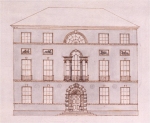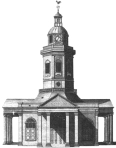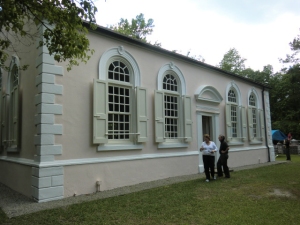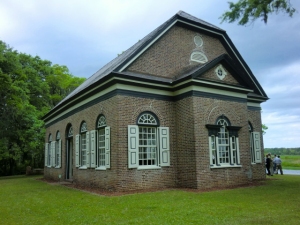Voted the Best Place to See by Condé Nast Traveler.

Architecture enthusiasts from across the southern United States converged on Charleston in mid-April for VITRUVIANA 2012: Charleston and the Development of American Architecture. The purpose of the 2-day program was to explore how Drayton Hall, the second St. Philip’s Church, and other landmarks in Charleston and the Carolina Lowcountry, were architectural pioneers in Colonial America and influenced building design throughout the colonies.
The Drayton Hall leadership is always alert for opportunities to educate about the place of Drayton Hall in the context of American architecture. George McDaniel, Drayton Hall’s Executive Director, responded quickly when the chance arose to partner with the Center for Palladian Studies in America, Inc., Clemson University, and the College of Charleston in presenting VITRUVIANA 2012. Carter C. Hudgins, Drayton Hall’s Director of Preservation and Education, teamed with Randy Boone, Director of Development, to lead Drayton Hall’s participation.
More than 90 people converged on the Circular Congregational Church’s Lance Hall for the kick-off event on April 13—an all-day symposium with distinguished speakers from Washington, D. C., Richmond, Williamsburg, Charlottesville, Atlanta and Savannah as well as Charleston. South Carolina attendees were joined by sizeable contingents from Richmond, Atlanta and elsewhere.

The Bingham House (1793, burned 1847), Philadelphia, influenced
Charleston’s noted Joseph Manigault House (1803).
Calder Loth opened the program with a fascinating review of the way Italian Renaissance architect Andrea Palladio has influenced architecture from 16th-century Italy to 18th-century Charleston—and ultimately to the present day. (Loth co-curated the landmark exhibition on Palladio which opened at the Morgan Library in New York in 2009.) Emilie Johnson of UVA traced Palladio’s influence in Jamaica and the Caribbean, and Carter C. Hudgins showed Palladio’s imprint on Drayton Hall.

The second St. Philip’s Church (c. 1721-1723; burned 1835, Charleston,
introduced the central steeple to America’s churches.
Prof. David Gobel of Savannah College of Art and Design told the remarkable story of how the second St. Philip’s Church (c. 1721-1723; burned 1835) introduced the central steeple to American churches, and Prof. Cynthia Kaye Fischer showed how Charleston’s famous Joseph Manigault House (1803), and other residences from Boston to Baltimore, were influenced by Philadelphia’s Bingham House (1793; burned 1847). Prof. Ralph Muldrow of the College of Charleston and Clemson’s Carter L. Hudgins added fascinating papers on Palladian motifs and on James Island’s Fenwick Hall near Charleston.
Charleston’s mayor, Joseph P. Riley, arrived to welcome the participants and to offer his insights on the preservation challenges facing Charleston in the 21st century. The day ended with a reception at the nearby Charleston Library Society, where staffers displayed beautiful 18th-century treatises and patternbooks from the Society’s own collection.
The second and final day of VITRUVIANA 2012 was devoted to a marathon bus tour visiting six of the historic 18th-century parish churches in the region surrounding Charleston. Tour leader Jonathan Poston set the tone. “I don’t think anyone has ever tried to do this,” he said. “I once visited five in one day, but never six.” The sold-out bus group was not daunted, and set off in festive spirits—which continued throughout the day. The churches all proved to be hidden treasures, tucked away in architectural splendor down narrow and obscure roads, often virtually unmarked.

St. James Goose Creek Church (c. 1707-1719), Berkeley County, was a sophisticated Palladian surprise.
Carl Lounsbury of Colonial Williamsburg, who lectured on the churches at the symposium the previous day, joined Jonathan in explaining the churches, their furnishings, and the political context which led to their construction.

The recently restored St. Thomas and St. Denis Parish Pompion Hill Chapel (1763-1765), Berkeley County, has a breath-taking site on the bank of the Cooper River.
It was a weary group of architecture buffs who descended from the bus at the end of the day, but they were happy in the knowledge that they had completed a truly extraordinary tour of precious but little-known gems of 18th-century America.
In fact, all of VITRUVIANA 2012 received superlative marks from those who attended, virtually ensuring that VITRUVIANA 2013 will soon be in the works for next spring!
Carl Gable is the president of The Center for Palladian Studies in America, Inc., and is a member of Drayton Hall’s Advisory Council. He divides his time between his home in Atlanta, and his Palladian villa in Italy.